Review: Viewfinder (game)

In Viewfinder you move around the world collecting photographs, and later taking them with a Polaroid camera. You then use the photos in your collection to solve puzzles ranging from "how do I get over there?" to "I need three batteries to power this teleporter, but I can only see one and it's behind a fence - what do I do now?". It's a really interesting dynamic, and there's a number of side quests and bonus levels. In this post I'm going to review Viewfinder, although I've not finished playing yet (time constraints).
I remember seeing some early tweets about the game, probably a year ago but maybe as far back as 2019, and thought "I really want to play that game" - onto my watch list it went. I then followed the release countdown and bought it within a few days of release 😄.
⚠ Warning - there will be some spoilers.
Disclaimer: I purchased Viewfinder with my own money and this is an unbiased review. I am not gaining any benefit from the company from this review, and the company does not know I am writing this.
My gaming setup
I'm playing this game on my laptop, running elementary OS Linux. Despite the game being written for Windows it seems to run quite nicely on Linux via the Proton library.
Hardware wise I'm running:
- Intel(R) Core(TM) i5-6300HQ CPU @ 2.30GHz CPU
- 16 GB RAM
- SSD for game files
- Nvidia GeForce GTX 950M dedicated graphics card (although I've possibly been playing on the Intel graphics card - this laptop has a dual card set up)
Game mechanic
Viewfinder is set in multiple stages, with each stage having a number of levels and some bonus levels. Your goal each level is to reach the teleporter to return to the staging area, with more levels unlocked each time you successfully complete one. After completing all levels in a stage you can get into the monorail car and move on to the next stage.
When you place a photo (either that you've taken yourself, photocopied, or found lying around) you can rotate the image. This allows you to turn a wall into a floor, for example, but also means that objects in the image obey their "new" gravity direction - you can make things fall towards you. The environment in the photo becomes three dimensional so you can interact with it, and depth is added.
Depending on how you place the photos you can end up with Castrovalva / Escher type effect:
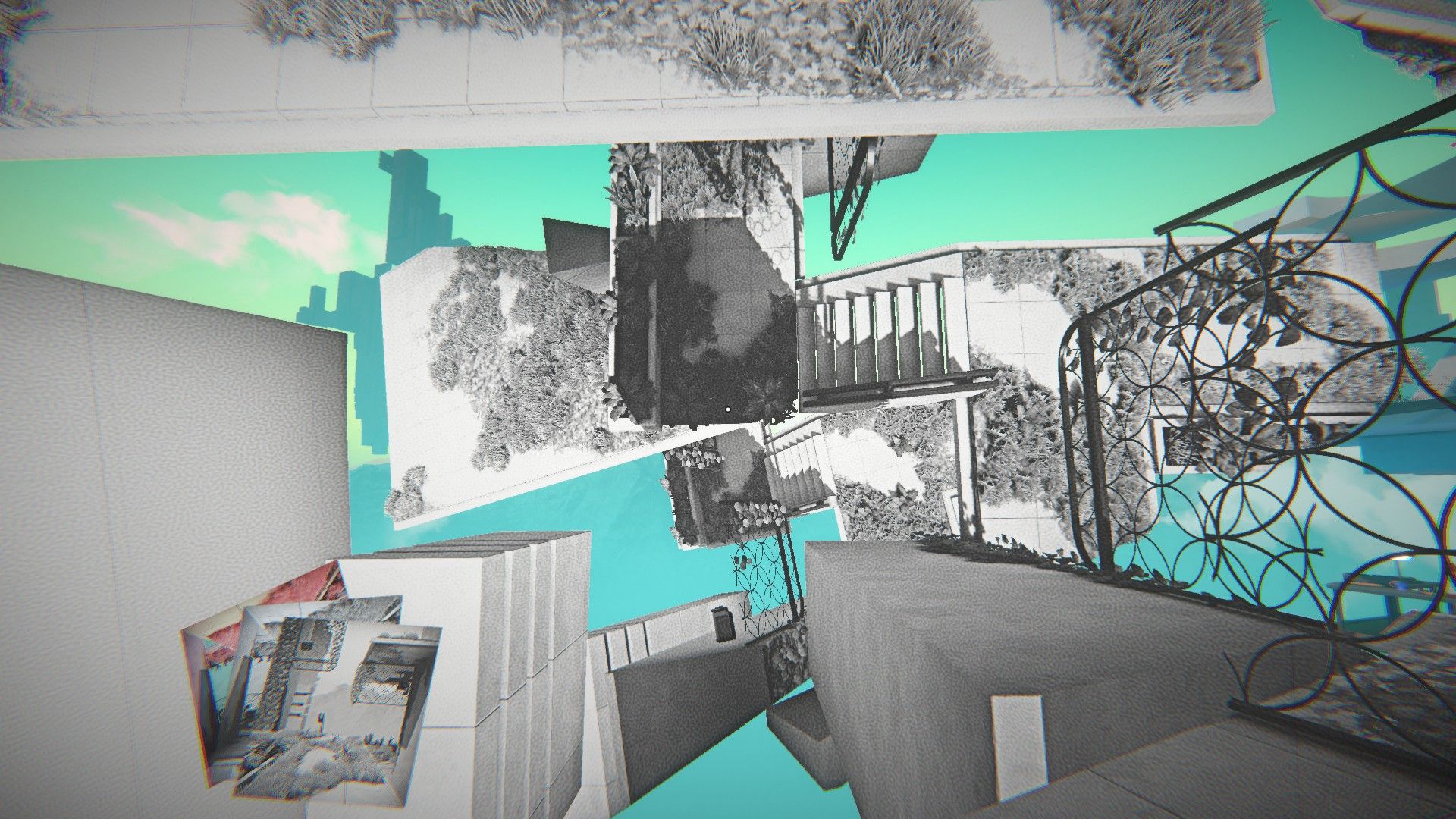
If you make a mistake, either by placing a photo in the wrong place, running out of photos, or falling to your death, Viewfinder has a nice mechanic where you can "rewind" to an earlier time. The timeline shows when you've taken and placed photos, so you can go back to just before (or after). While rewinding you you get a VHS style effect - for those of you that remember VHS tapes!
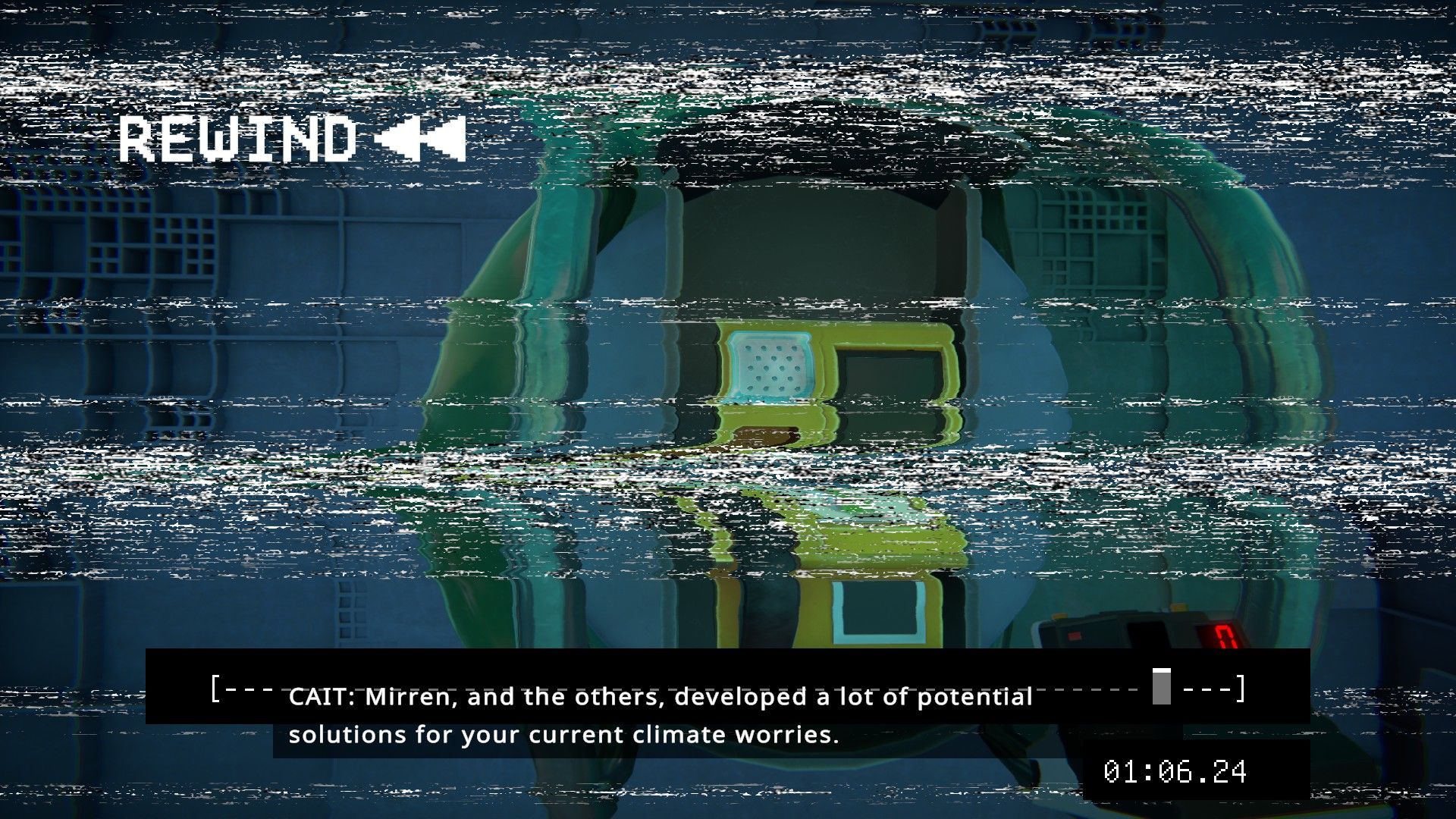
Each stage has side quests, where you have to collect items. I noticed these somewhat late, but have been keeping an eye out for small planets for one stage's quest.
On the easiest levels, all you have to do is get to an already powered teleporter. Later on you're introduced to batteries, which have to be placed on a charging pad that's connected to the teleporter (often you have to clone the battery), or to other triggers such as levers, sound detectors, and capacitors that only hold charge for a few seconds.
The Viewfinder world
The plot & challenge
I've not completed the game yet, so I don't know the full story line and plot yet. The story line is relatively loose, in that you get some hints but no defined story to follow. From what I've gathered, you are in a simulation and are solving puzzles trying to find some information that has been hidden. There's a lot of messaging about environmental disasters / global warming type concerns, and at points the game alludes to finding the solution "hidden somewhere".
Challenges in early levels are relatively simple, often requiring the player to collect photos in order to bridge a gap or get around an obstacle. In this regard the game gives the player an easy introduction, and steps you through what's necessary. Initially you cannot take photographs, you have to find existing pictures around the level. Eventually you get the ability to take photos (but only for a set number of "exposures") or are provided a photocopier to use to duplicate existing pictures. You can pick up packs of film to gain more exposures, and sometimes the solution involves making sure the pack of film is in the photo, so you can always take another picture.
As you progress the challenges get more difficult. Not everything can be photographed, and I was particularly stumped[1] for a while when I encountered blue batteries and teleporters. You cannot photograph these to duplicate or move them. Similarly some walls are immune to being photographed (or destroyed by placing a picture) so you have to plan accordingly. Fortunately all of the non-photographable elements look different, so it's quite obvious. All except Cait that is - you don't know you can't photograph Cait until you try and get told "no copycats"!
NPCs
There's a cat called Cait that seems to be part of the simulation - Cait's not entirely there and you can see through them (Cait is in the picture at the top of this post). Occasionally Cait will tell you things about the scientists and what they were working on. Mirren seems to have been the lead scientist, made the simulation and built the weather disruptor that we're looking for.
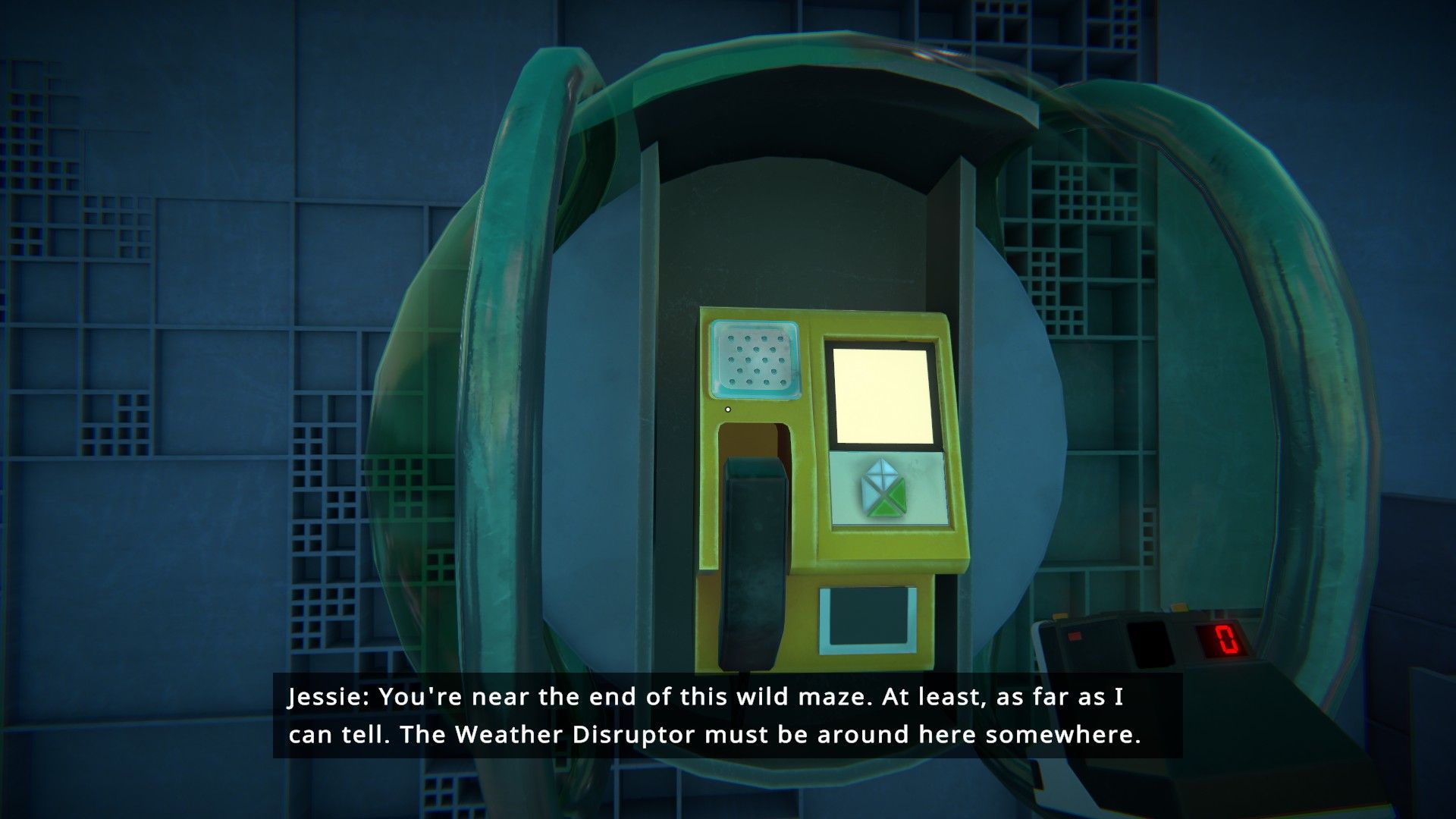
We get regular phone calls from someone called Jessie, who seems to be trying to guide us and help us on our way. Then there's at least two scientists who we only hear on recordings. One of them created the simulation, I think, and the others worked with them.
Audio and imagery
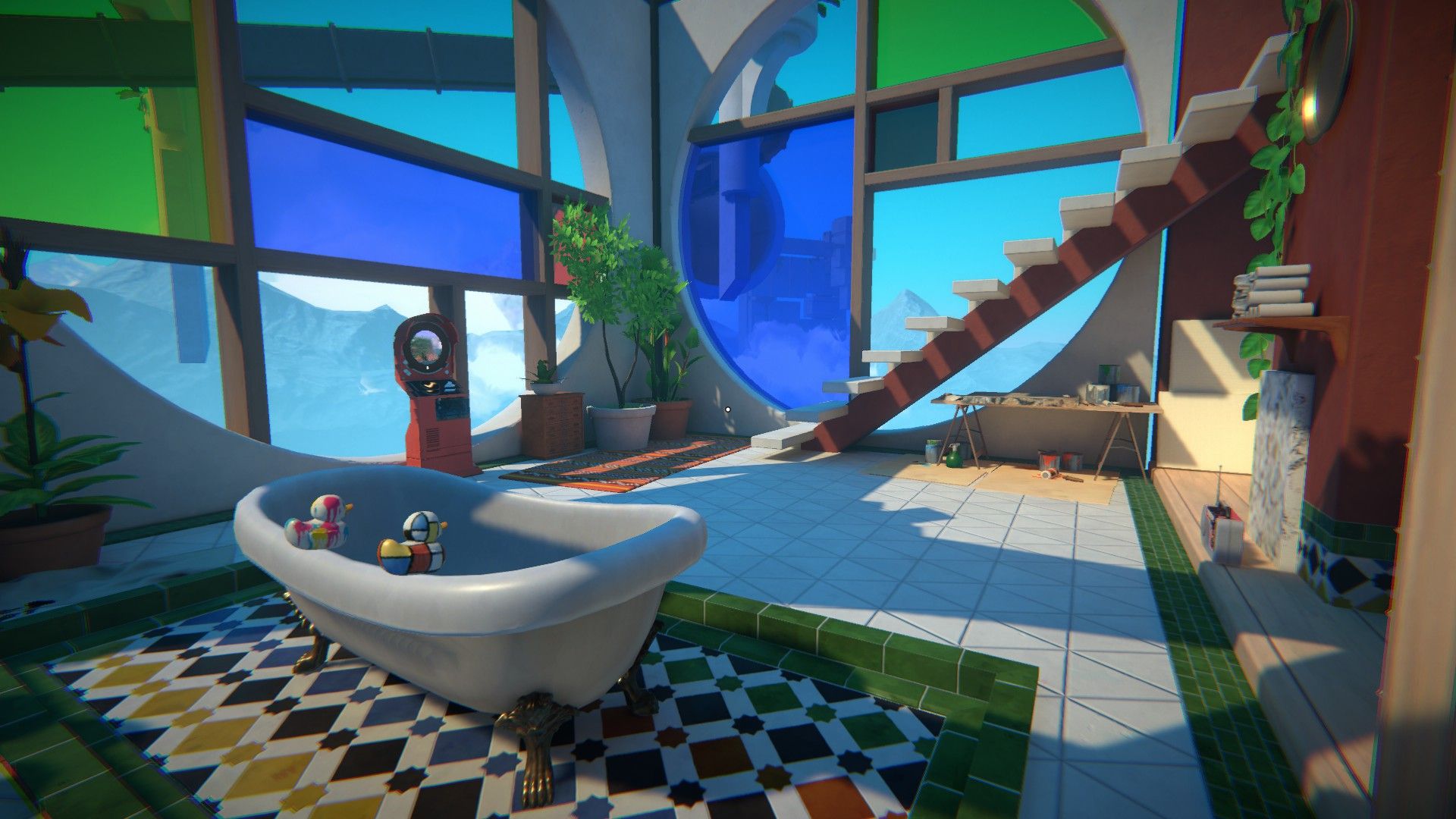
Different stages of the game have different visual designs, and looking out of windows / into the distance we can see other towers sitting among mountains. Levels in a stage tend to follow a visual style, although the player can change the effect applied to photographs they take (e.g. solarised, night vision, warm, cold). Sometimes a level has multiple visual styles, and the player has to move between different representations of the environment through portals like shown below. There a frames allowing you to pass into a different style of the current environment - blue print style on the left, painted in the middle, sepia tone on the right while we're stood in a black and white environment.
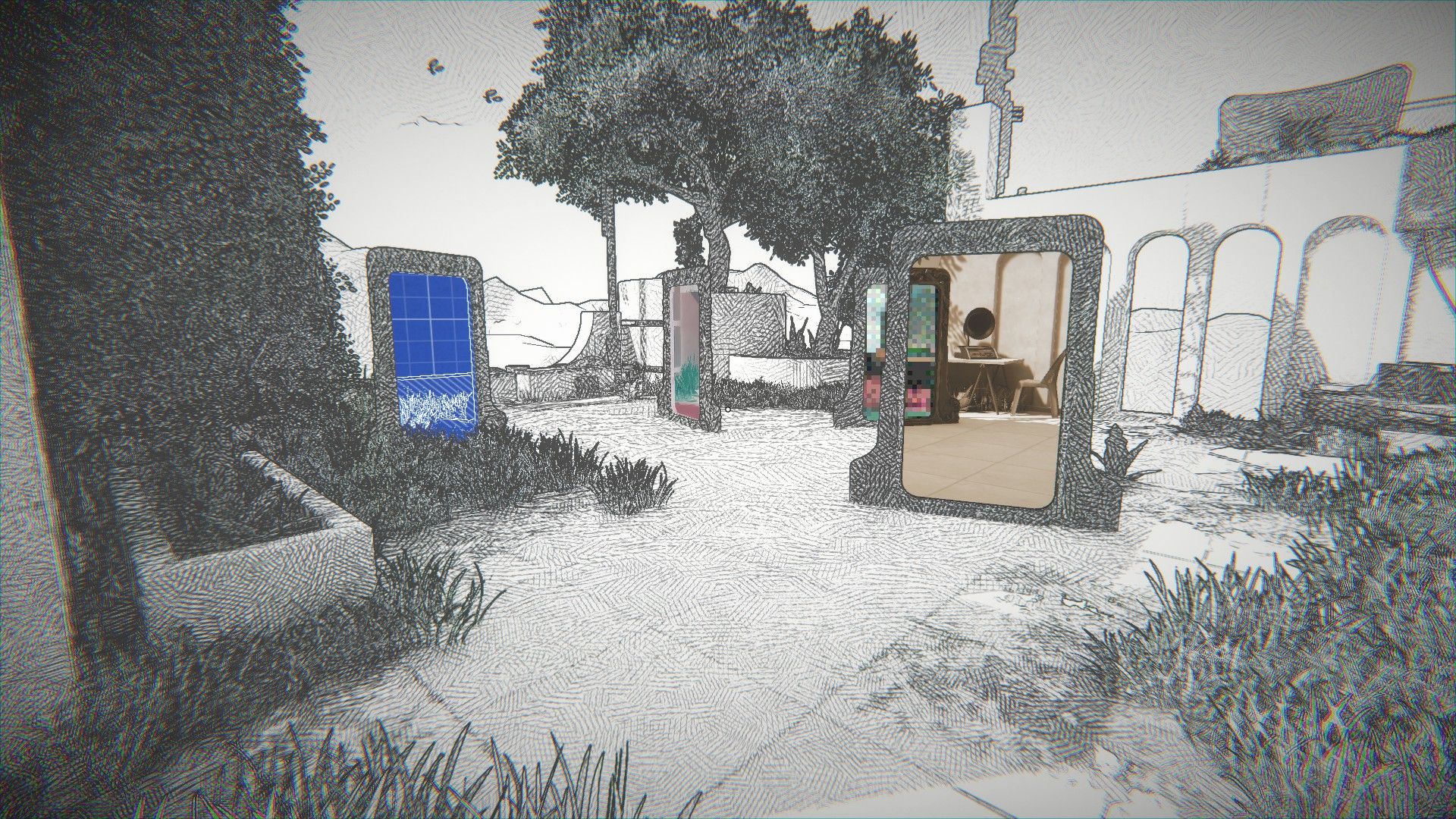
There are sticky notes / postit notes, and notepads around the levels with other messages too. The walls are adorned with posters referencing a band, or suggesting that we explore beyond the sun. Notes and writing on the chalk boards often relate to mathematical equations or science in some way.
Other than the telephone, some messages are left as "found audio" on what look like vinyl record players. You walk up to the equipment and interact with it to hear the message. These "found audio" messages remind me of the Within The Wires podcast.
There's some soft background music that plays on a loop. It's quite unintrusive and pleasant.
Overall
Viewfinder is a fun game, and I'd certainly recommend it to you if you like puzzles. It uses a mechanic I've not played with before, which only makes it more interesting.
Where's the game from?
Viewfinder is a game from Sad Owl Studios, who I didn't realise were a Scottish game development studio - nice to be playing a game from the British Isles.
Where can I get it?
Viewfinder can be found on Steam and is coming soon to the PlayStation Store. At the time of writing (20th September 2023) the game is priced £19.99 (US $24.73), which is what I paid for it. I think that's quite a fair price given that's around the cost of two cinema tickets where I live, and Viewfinder will take you longer to complete than one standard movie (plus you can play it again).
Banner image: A screenshot from the game.
[1] stumped - to be stuck or confused

